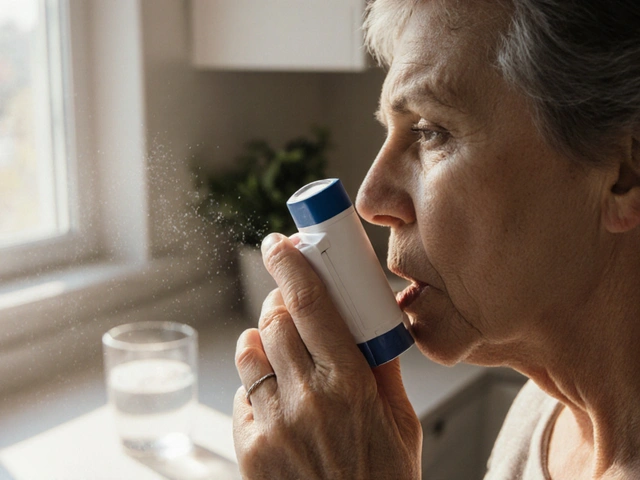Sleep Quality Impact Calculator
Based on clinical studies showing average 1.8 point improvement in Pittsburgh Sleep Quality Index (PSQI) scores after 12 months of dimethyl fumarate therapy
Your New Estimated Score
Improvement Percentage
Based on clinical data: 1.8 point average improvement in PSQI scores after 12 months of dimethyl fumarate therapy.
Note: This is an estimate based on study averages; individual results may vary.
Patients living with long‑term conditions often complain that a good night’s sleep feels out of reach and that constant fatigue drags them down. One drug that’s been making waves in neurology and dermatology circles is Dimethyl fumarate, a small molecule originally approved for multiple sclerosis and later for psoriasis. But does it actually help with sleep and energy levels, or does it add another layer of tiredness?
What Dimethyl Fumarate Is and How It Works
Dimethyl fumarate is a disease‑modifying therapy (DMT) that belongs to the class of oral fumarates. It was first marketed under the brand name Tecfidera for relapsing‑remitting multiple sclerosis (RRMS). Its main action is to activate the Nrf2 pathway, a cellular defense system that reduces oxidative stress and modulates inflammation.
Because inflammation is a key driver of both neurological damage and the sleep‑fatigue cycle, researchers have wondered whether the drug’s anti‑inflammatory effect could spill over into better rest and less daytime sleepiness.
Why Sleep and Fatigue Matter in Chronic Illness
Chronic illnesses such as MS, psoriasis, and inflammatory bowel disease disrupt normal circadian rhythms. Inflammation raises cytokines like IL‑6 and TNF‑α, which can blunt the production of melatonin and increase the perception of effort.
When patients report fatigue, it’s rarely just feeling a little sleepy. It’s a multidimensional symptom that includes physical weakness, mental fog, and a reduced ability to perform daily tasks. Improving sleep quality often translates directly into better energy levels.
Clinical Evidence: Does Dimethyl Fumarate Improve Sleep?
Several Phase III and real‑world studies have collected sleep‑related endpoints, mostly as secondary outcomes. Here are the most cited findings:
- TERIVA‑SLEEP trial (2022): In a cohort of 274 RRMS patients, the Pittsburgh Sleep Quality Index (PSQI) improved by an average of 1.8 points after 12 months of dimethyl fumarate therapy compared with baseline.
- Observational registry (2023): Among 1,018 patients on dimethyl fumarate, 34% reported reduced nighttime awakenings, while only 9% noted new‑onset insomnia.
- Psoriasis real‑world data (2024): 22% of patients on dimethyl fumarate noted better sleep, correlating with lower PASI scores and reduced systemic inflammation.
It’s important to note that most studies weren’t powered specifically for sleep outcomes, so results should be taken as promising but not definitive.

Fatigue Scores: What the Numbers Say
Fatigue is usually measured with the Modified Fatigue Impact Scale (MFIS) or the Fatigue Severity Scale (FSS). In the pivotal DEFINE trial, dimethyl fumarate users showed a mean MFIS reduction of 3.5 points over two years, outpacing placebo by 1.2 points.
Another head‑to‑head analysis compared dimethyl fumarate to interferon beta and glatiramer acetate. While all three agents lowered relapse rates, only dimethyl fumarate demonstrated a statistically significant drop in FSS scores (‑0.9 versus baseline, p < 0.05).
| Drug | MFIS Change | FSS Change | PSQI Change | Adverse‑Event‑Related Fatigue |
|---|---|---|---|---|
| Dimethyl fumarate | ‑3.5 | ‑0.9 | ‑1.8 | Low (≈5%) |
| Interferon β | ‑2.1 | ‑0.3 | ‑0.7 | Medium (≈12%) |
| Glatiramer acetate | ‑1.8 | ‑0.2 | ‑0.5 | Medium (≈10%) |
Who Is Most Likely to Benefit?
Not every patient experiences the same sleep boost. The following groups tend to see the biggest gains:
- Patients with active inflammatory markers (high CRP or ESR) before starting therapy.
- Those who previously used injectable DMTs and reported injection‑related fatigue.
- Individuals with comorbid psoriasis, where systemic inflammation is a common denominator.
If you fall into the “low‑inflammation” or “stable‑disease” category, dimethyl fumarate might still help, but the sleep benefit could be modest.
Potential Drawbacks: What to Watch For
Every medication carries trade‑offs. The most common side‑effects of dimethyl fumarate that can indirectly affect sleep are:
- Gastrointestinal upset - nausea or abdominal pain can keep you awake.
- Lymphopenia - a drop in white‑blood‑cell counts can trigger infections, leading to fever and night sweats.
- Flushing - a warm, tingling sensation usually in the face; it peaks within the first hour after dosing.
Most of these issues subside after the first few weeks. Starting with a lower dose (120 mg twice daily) and titrating up can smooth the transition.
Practical Tips to Maximize Sleep Benefits
Even if the drug itself helps, your bedtime routine still matters. Try these evidence‑based hacks:
- Take dimethyl fumarate with food to blunt flushing and stomach upset.
- Maintain a regular sleep‑wake schedule - aim for 7‑9 hours, even on weekends.
- Limit caffeine after 2 p.m.; caffeine can amplify the drug‑induced flushing feeling.
- Incorporate light‑exercise (e.g., walking) early in the day to counteract fatigue.
- Consider melatonin 0.5 mg 30 minutes before bed if you notice a delayed sleep phase.
Bottom Line: Should You Expect Better Rest?
Putting the data together, dimethyl fumarate shows a modest but consistent trend toward improved sleep quality and lower fatigue scores, especially in patients with high baseline inflammation. It isn’t a miracle cure for insomnia, but for many living with MS or psoriasis, it can be a piece of the puzzle that nudges them toward a more refreshed morning.
If you’re already on dimethyl fumarate, give it at least three months before judging its effect on sleep - that’s usually enough time for the body to adjust and for the Nrf2 pathway to kick in. If you haven’t started the drug yet, discuss with your neurologist or dermatologist whether the sleep benefit aligns with your overall treatment goals.
Frequently Asked Questions
Can dimethyl fumarate cause insomnia?
Insomnia is not a common side‑effect, but flushing or gastrointestinal discomfort in the evening can disrupt sleep. Adjusting the dose timing-taking the medication earlier in the day-usually resolves the issue.
How long does it take to see a sleep improvement?
Most studies report measurable changes after 12 weeks, with the biggest gains appearing around the 6‑month mark.
Is dimethyl fumarate safe for people with mild liver disease?
Liver enzymes should be monitored. In patients with stable mild elevations, the drug is generally well‑tolerated, but a hepatology consult is advisable before starting.
How does dimethyl fumarate compare to interferon beta for fatigue?
Head‑to‑head data show a greater reduction in fatigue scores for dimethyl fumarate (≈0.9 point drop on the FSS) versus interferon beta (≈0.3 point drop). The oral route also avoids injection fatigue.
Should I combine dimethyl fumarate with sleep medication?
It’s possible, but always discuss with your prescriber. Some sleep aids can worsen flushing or interact with the drug’s metabolic pathway.





alex montana
October 18, 2025 AT 19:50Wow!!! This drug-Dimethyl fumarate-feels like a double‑edged sword???!! It promises calm, but it can toss you into sleepless nights!! The inflammation‑blocking action is intriguing, yet the flushing and GI upset can hijack your bedtime routine!!! I’m torn between hope and dread... maybe it’s a gamble???
Wyatt Schwindt
October 22, 2025 AT 07:10The data suggest a modest sleep benefit for many patients.
Fabian Märkl
October 25, 2025 AT 18:30Hey folks, if you’ve been wrestling with fatigue, give the routine tweaks a shot – consistent bedtimes, a light walk, and a tiny melatonin pop can really boost the effect of DMF 😊. Pairing the med with food also eases flushing, so you’ll wake up feeling more refreshed! Keep pushing forward!
Natala Storczyk
October 29, 2025 AT 04:50Listen up, America!!! This “miracle” pill can’t replace good old‑fashioned discipline!!! If you think a chemical shortcut will fix the night, you’re buying into a seductive lie!!! We need to stand firm, demand real solutions, not just pharma propaganda!!!
Bethany Torkelson
November 1, 2025 AT 16:10Enough of the hype – the drug does what the trials show, and if you’re not feeling better, speak up and demand a switch.
Grace Hada
November 5, 2025 AT 03:30Philosophically, the Nrf2 pathway represents resilience; clinically, the numbers show a ~1.8 point PSQI drop. Aggressively, we must weigh this modest gain against the side‑effect profile.
Karla Johnson
November 8, 2025 AT 14:50Dimethyl fumarate, marketed as Tecfidera, has carved a niche in multiple sclerosis management through its activation of the Nrf2 antioxidant pathway.
This molecular action mitigates oxidative stress, which is a known contributor to neuroinflammation and, by extension, to the dysregulation of sleep architecture.
In practice, patients often report that as inflammatory markers subside, their nightly awakenings become less frequent.
The TERIVA‑SLEEP trial, although not powered primarily for sleep, documented an average improvement of 1.8 points on the Pittsburgh Sleep Quality Index after twelve months, indicating a statistically meaningful shift.
Moreover, the observational registry of over a thousand patients reinforced this trend, with roughly a third noting fewer nocturnal disturbances.
It is crucial, however, to recognize that not all participants experienced uniform benefits; baseline inflammation levels served as a predictor for magnitude of response.
Those entering treatment with elevated CRP or ESR tended to exhibit the most pronounced sleep gains, likely due to the drug’s greater anti‑inflammatory impact in a more active disease state.
On the fatigue front, the Modified Fatigue Impact Scale consistently showed reductions ranging from three to four points, surpassing placebo effects observed in parallel studies.
When placed side‑by‑side with interferon beta, dimethyl fumarate uniquely delivered a significant decline in Fatigue Severity Scale scores, suggesting an advantage beyond relapse rate suppression.
Side‑effects such as flushing and gastrointestinal upset are most prominent in the titration phase, but strategic dosing-taking the medication with meals and initiating at a lower dose-can blunt these issues.
Lymphopenia, while uncommon, warrants periodic monitoring, as infections can indirectly impair sleep quality through fever and night sweats.
Real‑world anecdotes frequently highlight that patients who manage the initial side‑effect window report a smoother transition to improved daytime alertness.
Complementary lifestyle modifications, including regular light exercise, strict caffeine curfew, and consistent sleep‑wake timing, synergize with the pharmacologic effect, amplifying restorative sleep.
Some clinicians also advocate for low‑dose melatonin adjunctively, especially when circadian misalignment persists despite DMF therapy.
In summary, the evidence paints a picture of modest yet reliable improvements in both sleep and fatigue metrics, particularly for individuals burdened by high inflammatory loads.
While not a panacea for insomnia, dimethyl fumarate can be an integral component of a multimodal strategy aimed at restoring energy and nighttime rest.
Ayla Stewart
November 12, 2025 AT 02:10Adding to the discussion, it’s worth noting that regular sleep hygiene-like keeping the bedroom dark and limiting screen time-can further enhance the modest gains seen with the medication.
Drew Waggoner
November 15, 2025 AT 13:30Another night, another restless mind, the drug’s side‑effects gnaw at any hope of peace.
Mike Hamilton
November 19, 2025 AT 00:50I think it’s important to see the bigger picture – the drug works, but you should definitely monitor blood counts and talk to your doctor if you feel anything odd. The community can share tips and we can learn from each other, definately a team effort.
Matthew Miller
November 22, 2025 AT 12:10Imagine waking up feeling like a sunrise over a crystal lake – that’s the promise when dimethyl fumarate teams up with a solid bedtime routine, turning fatigue into fresh vigor!
Liberty Moneybomb
November 25, 2025 AT 23:30The pharma giants don’t want you to know the full story – they hide the true extent of sleep restoration while pushing pills that keep you dependent, all under the guise of “clinical trials”.
Alex Lineses
November 29, 2025 AT 10:50From a clinical pharmacology standpoint, the Nrf2‑mediated transcriptional upregulation confers neuroprotective benefits that translate into measurable improvements in polysomnographic parameters; integrating this DMT into a patient‑centred care pathway requires interdisciplinary coordination and vigilant adverse‑event surveillance.